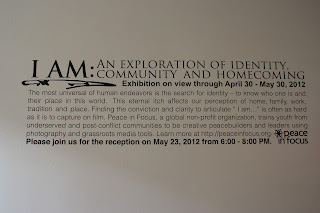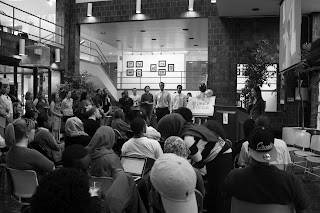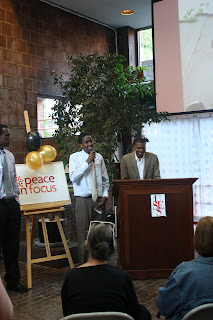Try
to picture it--- 15 high school students in a small room, excitedly fiddling
with their new cameras; chatter, laughter, snapping photos. This is the image
of the Peace in Focus Workshop #2—Introduction to Digital Storytelling. Our
second workshop of the summer ran from July 8th through July 19th.
Our all-star college students arrived on Day 1 of the workshop full of energy
and ready to pass all their knowledge on to the high school students. The room
was filled with dedicated youth, ready to work together as young leaders and
change their community for the better.
Similarly
to Workshop 1, we made our way through the Peace in Focus manual. Almost every
day we took breaks, usually to go outside. Frequently we broke out into small
groups and went on photo scavenger hunts around the neighborhood. Students
responded very well to our activities. One of their favorite parts was
re-grouping after small group photo time and viewing each other’s work. They
were inspired and motivated by each other.
Many
of the students indicated that one highlight of their experience was a series
of debates that we had surrounding the question of photography used as a way to
display the raw truth of conflict in the world, and photography as a way of
exploiting poverty and war zones. I shot a great video of one of these debates,
and will try my best to upload it here to the blog. If that doesn’t work, I
will post a link to the video later. The debate truly split the room-- half the
students advocated that photography can be a powerful tool to tell the world
what’s happening in a given area, while the other half wholeheartedly believed
that too often, photography is a tool of exploitation, and that photos of
impoverished children and war-torn areas do not create effective change. Of
course, there was no right answer, but it is a critical question to consider while pursuing a career in photography or photo journalism.
For
us, it was incredibly rewarding to see our trained college students take strong
leadership roles for Workshop 2. This was a pilot model for us, and we look
forward to using it again in the future, and to teaching this model to other
organizations. We are well aware that it is difficult to sustain small projects
such as this, but perhaps this model is the key to continuing PIF work. We hope
that next year, our trained PIF facilitators at ACEDONE will be able to
continue this important work, and work with a new group of high school students
in the Roxbury community. They are now equipped with the tools, experience, and
passion to continue fueling the project!
To view all of our photos from Workshop 2, visit our Facebook.











































